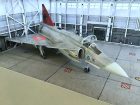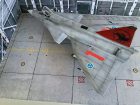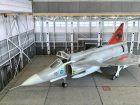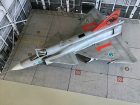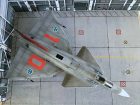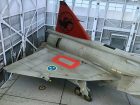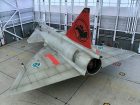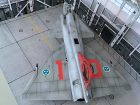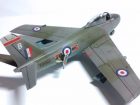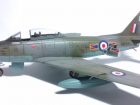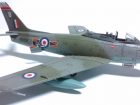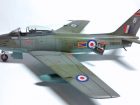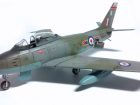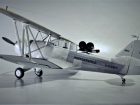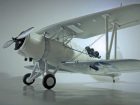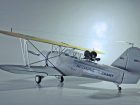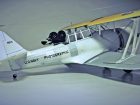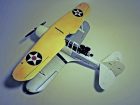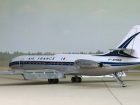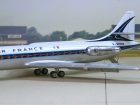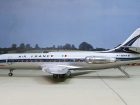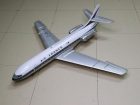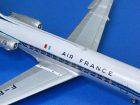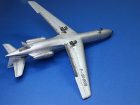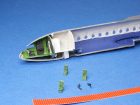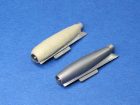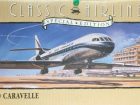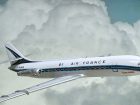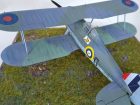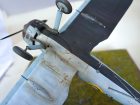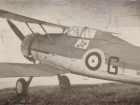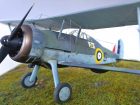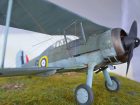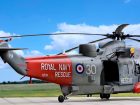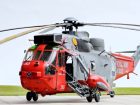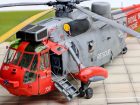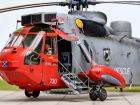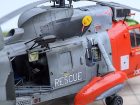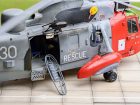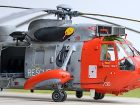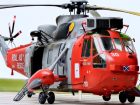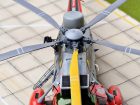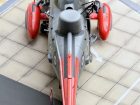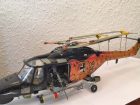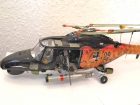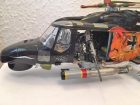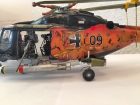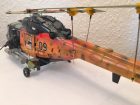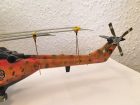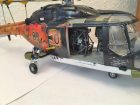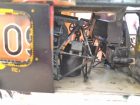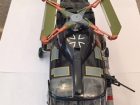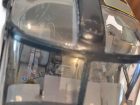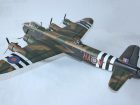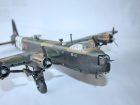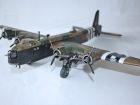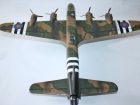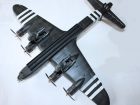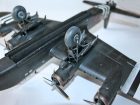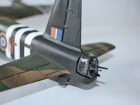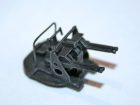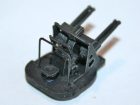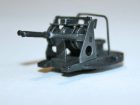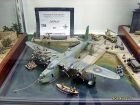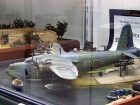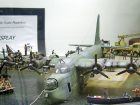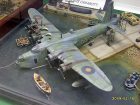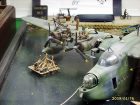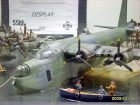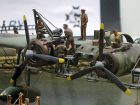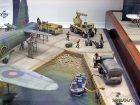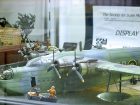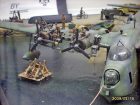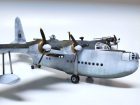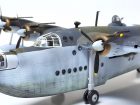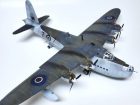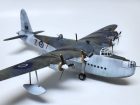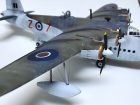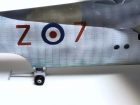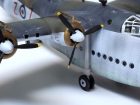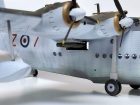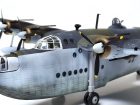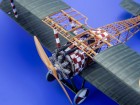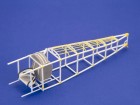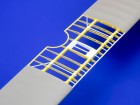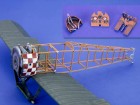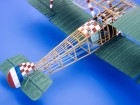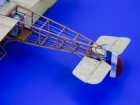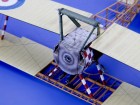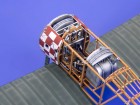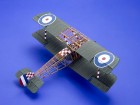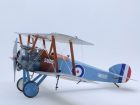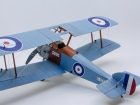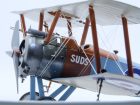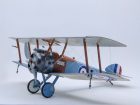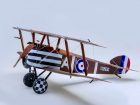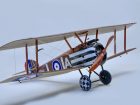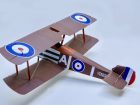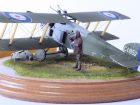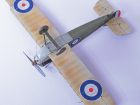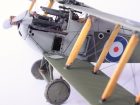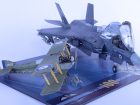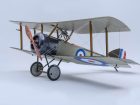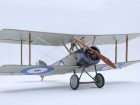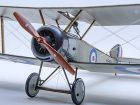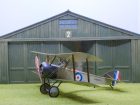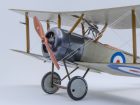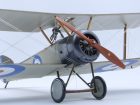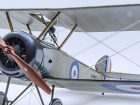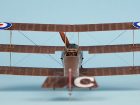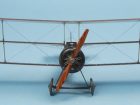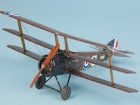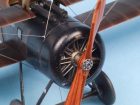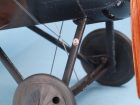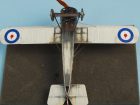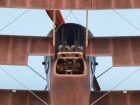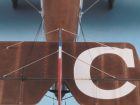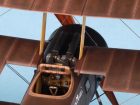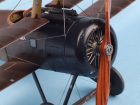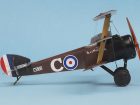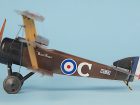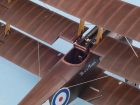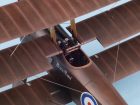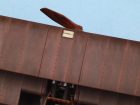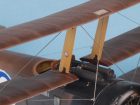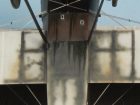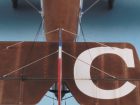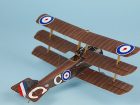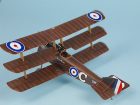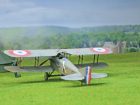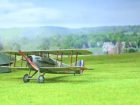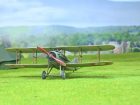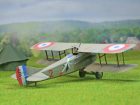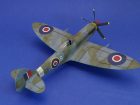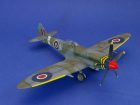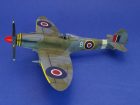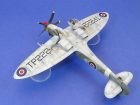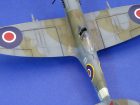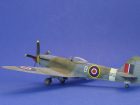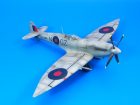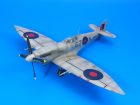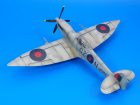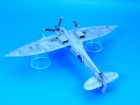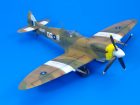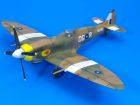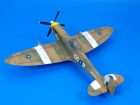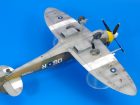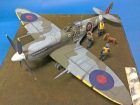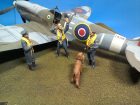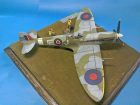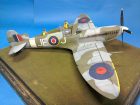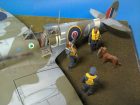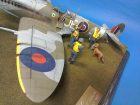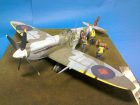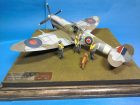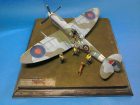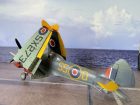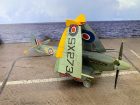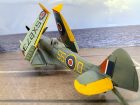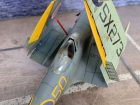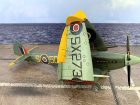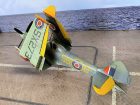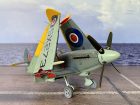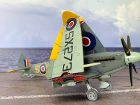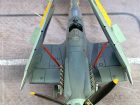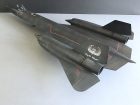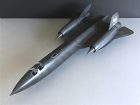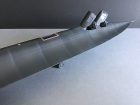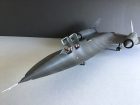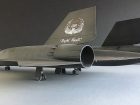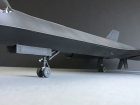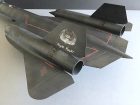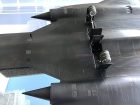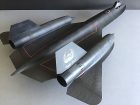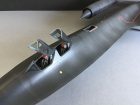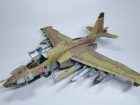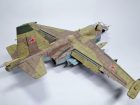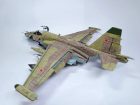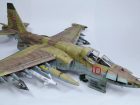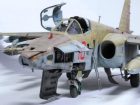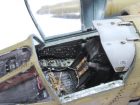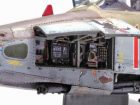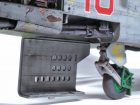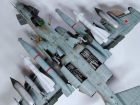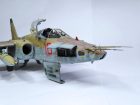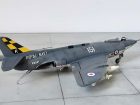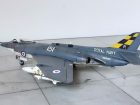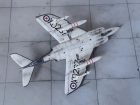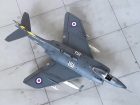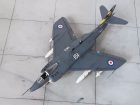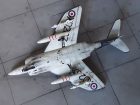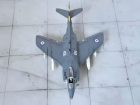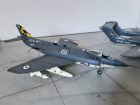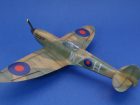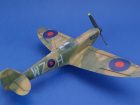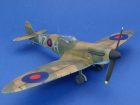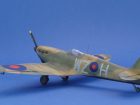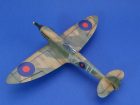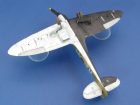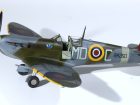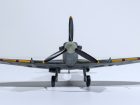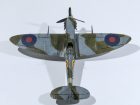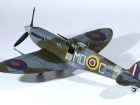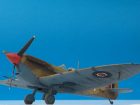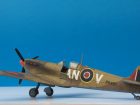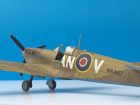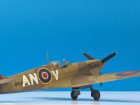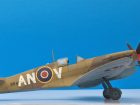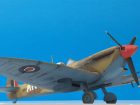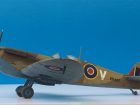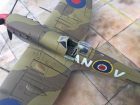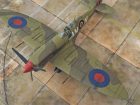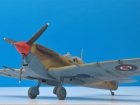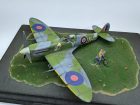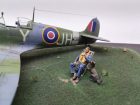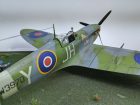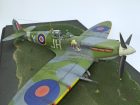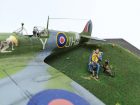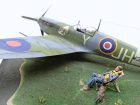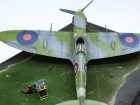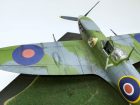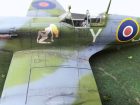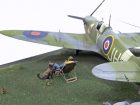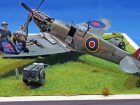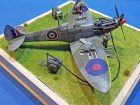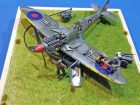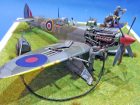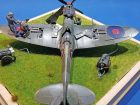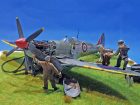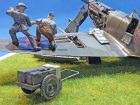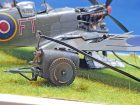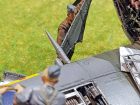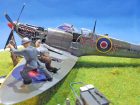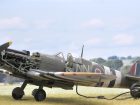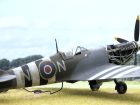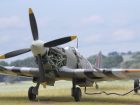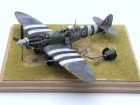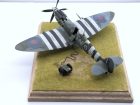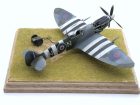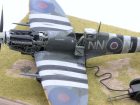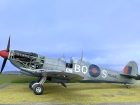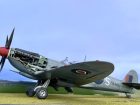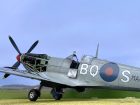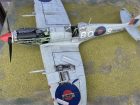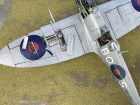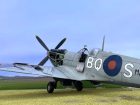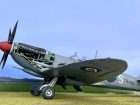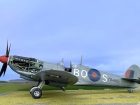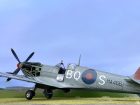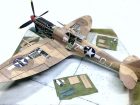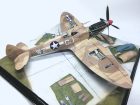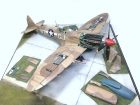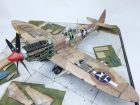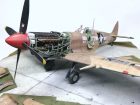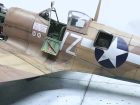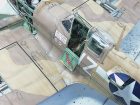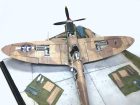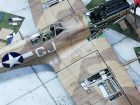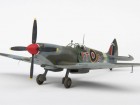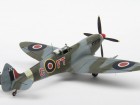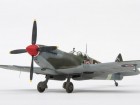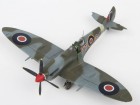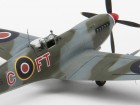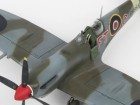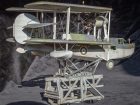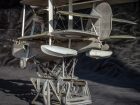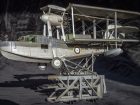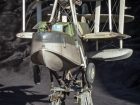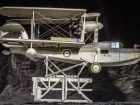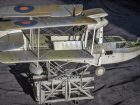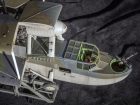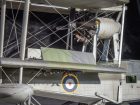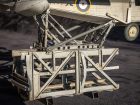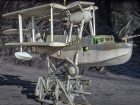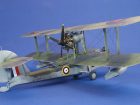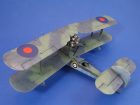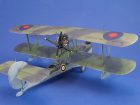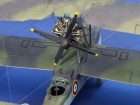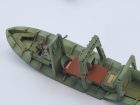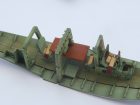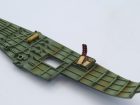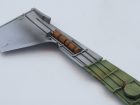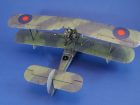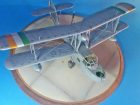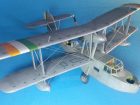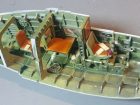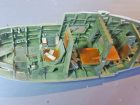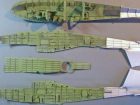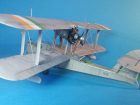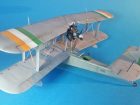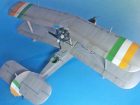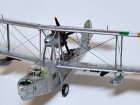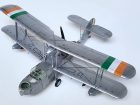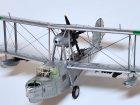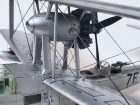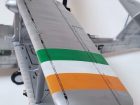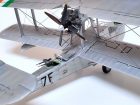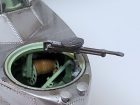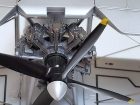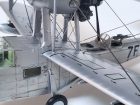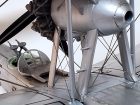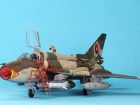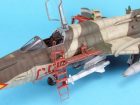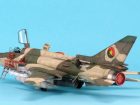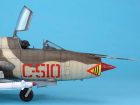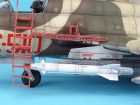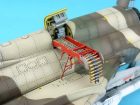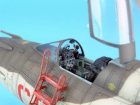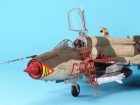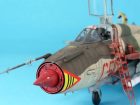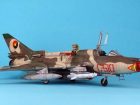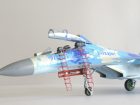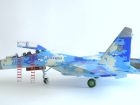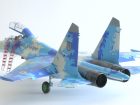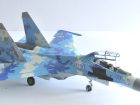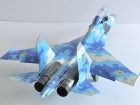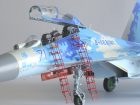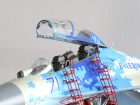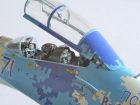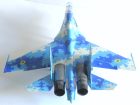More of our Subscribers’ amazing aircraft: S
Galleries: A | B | B-2 | C | D | F | G | H | I-L | M | N-R | S | T-V | W-Z
Each submission has a ‘gallery’ of thumbnails which you can click on to see an enlarged image and read the short text describing the model – enjoy!
May I present to you my 1:48 scale build of the SAAB ‘AJ-37’ Viggen.
This is the Special Hobby kit and built out of the box apart from an aftermarket pitot probe (Master) and Decal Sheet (Moose Republic).
The kit has pleasing recessed surface details and I found it to be an enjoyable build experience and didn’t find any areas of major-issue during the process. It certainly captures the look of the Viggen to a tee in my book.
I primed the model in Mr.Surfacer 1500 Grey mixed 50:50 with Levelling Thinner and completed the paint scheme with Mr.Hobby Aqueous acrylics, again mixed in the same ratio with Levelling Thinner. I brush-applied a coat of Klear/Pledge to seal the paint surface in readiness for the decaling stage. The Moose Republic decals responded perfectly with just Micro Sol. I avoided using Micro Set because I wanted to make sure I had enough working time to position the tail markings satisfactorily.
An airbrushed coat of Mr Hobby Clear Semi-Gloss was applied overall prior to final assembly. Tamiya weathering pastels were used for that final touch.
I wish to add that this build was my first serious attempt at weathering a model and I must thank Geoff and SMN for my learning and raising my confidence to attempt what has now become a stage I thoroughly enjoy and relish carrying out on all my subsequent projects.
I hope you enjoy viewing and thank you for doing so.
All The Best,
Paul. A
I had originally intended to convert the model to a “Blue Goose” command aircraft and use the magnificent decals for other projects. (To date I have used the Pointer Dog Insignia of Scouting Squadron Two on a Dauntless. They look, to coin a phrase of the day “Just Dandy”). When I finally got round to thinking about starting this model, Lukgraph had already made a Blue Goose variant so I changed direction and built a version of the aircraft away from front line duty at NAS Penascola where the majority of SBU-1 aircraft were stationed in reserve by Dec 1941. This one is assigned to the Navy Photographic Service and is based on an image from William T Larkins “US Navy Aircraft 1921 -41”
I am not aware of any of large movie cameras being fitted to the SBU- 1 in real life, but examples were fitted to aircraft in Hollywood, most notably in the filming of the Howard Hughes Epic “Hells Angels”. Large and heavy mapping cameras were bolted to USN aircraft at Penascola though, principally, Fairchild K series. I took the liberty to replace the aircraft’s defensive machine gun, which certainly would never have been used in anger. The camera fitted here is a scratch-built Mitchell 16mm. It is the classic Hollywood camera of the era, used widely for filming stars such as Humphrey Bogart, Cary Grant and Carole Lombard. It was a camera definitely used by the USN, but possibly not as modelled here. It’s built from bits out of the scrap box, and I hope I have captured the feel of this hefty piece of apparatus.
The rest of the plane is from the box, apart from the glasshouse framing, which I replaced with white parallel lines decals from Hannants. Other Hannants decals were used for the “PHOTOGRAPHIC” insignia on the side of the fuselage. I used numerous shades of white from various paint suppliers to get a representative effect on the different panels.
Alan R.
- The kit is a new release and very nicely detailed and finished and reminiscent of the earlier FR 46/47 kits
- The build quality is similar to their MK.XII Spitfire
- The kit offers three schemes
- I just added seatbelts
- I used Xtracolor paints and the kit decals which are of good quality and go down very well
- The model was finished off with a coat of Humbrol Matt Cote.
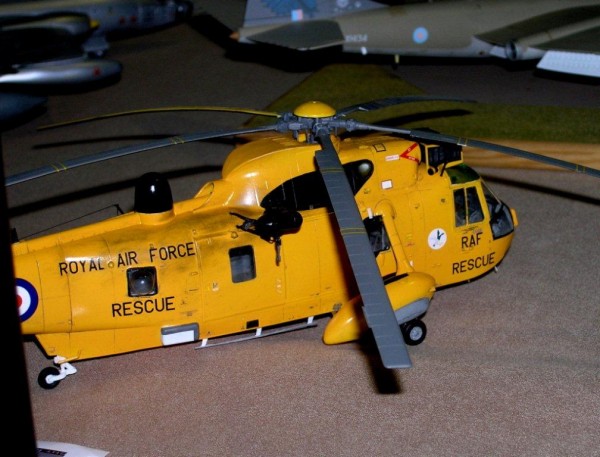
The basic kit is the Revell offering of the Hasegawa tooling modified to represent a Sea King HAR 3A. To achieve this I used the Flightpath Sea King conversion set, and a few personal adjustments that were not provided in the kits. I also got the sand filter from Flightpath as an extra. This was my first attempt at airbrushing as well as etched brass, weathering and conversion. This is all the result of what I have learnt at both S.L.A.M. (IPMS South Lincolnshire Association of Modellers) and Cranwell clubs, which helped to achieve its second place award at the Newark show.

The basic kit is the Revell offering of the Hasegawa tooling modified to represent a Sea King HAR 3A. To achieve this I used the Flightpath Sea King conversion set, and a few personal adjustments that were not provided in the kits. I also got the sand filter from Flightpath as an extra. This was my first attempt at airbrushing as well as etched brass, weathering and conversion. This is all the result of what I have learnt at both S.L.A.M. (IPMS South Lincolnshire Association of Modellers) and Cranwell clubs, which helped to achieve its second place award at the Newark show.
This build came about after I published pictures of my Sea King ASaC7 when a Welsh guy living in Slovakia gave me some great feedback and I said that I had another kit in the stash, an HAS3. We then spent some time discussing what colours it should be in and agreed it would look nice as a Royal Navy rescue bird. It so happened that Mike owns three real Sea Kings, an HU5, HAS3 and an HC4. Quite quickly I agreed to build it as his HU5 as a commission. Mike and the Sea King community provided lots of excellent reference material and assistance during the 65 hour build.
The Hasegawa kits do not have any detail in the rear cabin and the doors are moulded closed, so first thing was to open the doors. I then built the radar console from scratch. Lots of aftermarket was used in this build, the main exterior conversion coming from Whirlybird, which was an improvement over the Flightpath conversion used on the ASaC7, but some components were soft and kit parts and parts left over from the ASaC7 conversion were used as well. Other parts came from eduard, Montex, Quickboost and Reskit. The exterior was painted using MRP lacquers.
David B.
Here is my Short Stirling Mk.III, a good old Airfix kit with more realistic surfaces than the Italeri one…
The front and rear turrets have been improved with plastic strips and rods. It’s not really the exact interior arrangement of the turrets but through the clear parts, it gives a good impression.
This aircraft (LJ522) saw service with 218 (Gold Coast) Squadron at Woolfox Lodge. On June 6th 1944, she took part in Operation “Glimmer”, dropping window strips over the Pas-de-Calais to confuse the German radars.
Willy S.
The kit is the old Airfix 1:72 scale model …a short story to this diorama …..
This diorama was actually modelled from a crude photograph taken at that time. This particular aircraft arrived from Alexandria for a technical and fuel stop in Malta. It had engine failure on take off at Kalafrana Sea Base. The engine change was made on the slipway (which still stands to this very day) to get the aircraft out of Malta as soon as possible as air raids were becoming deadlier and more frequent.
I am from Malta and we really took a pounding and had it very bad ….Sicily which being part of Axis held territory being only 60 miles away!
Louis C.
The kits start with the interior, with manly wooden construction on the original aircraft, some wood effect painting techniques are required. A few options are available, my preferred choice is oil paint dragged over the plastic to give a nice wood grain effect. The instruments are applied in the form of separate decals which are supplied with the kit.
Once the fuselage halves are joined, you need to paint the fuselage and apply the decals, as once the wings and struts are fitted, you would have limited access. For all my First World War builds I use MRP paint, they do a good range of specific colours for the WW1 aeroplanes.
Many modellers are put off multi wing aircraft, this is due to the rigging. I had exactly same view, that was until I built my first Wingnut Wings kit. The process really is not as difficult as many people believe. For the British rigging, which was a flat aerodynamic design, I use sew in elastic, this is also flat and very cheap. Holes are marked on the kit mouldings for the holes, just drill these holes out a little and place the elastic inside with superglue.
The markings are 10 Squadron of the Royal Navel Air Service in January 1918.
I’m not for one moment saying these kits are easy and should be undertaken by novice modellers, but if you’ve built models before, you’ll be surprised at the amount of detail and stunning models these kits provide, yes, they are expensive, but quality comes at a cost.
Andrew R.
This aircraft is part of my model clubs Tangmere 101 display at the museum. Copper State Models Sopwith Dolphin premium edition is sublime, with PE parts and a highly detailed engine.This particular aircraft is in a photo in the museum, special archive, shown at Tangmere in 1918 with a pilot from 29 Sqn having a look over it. If you notice the actual aircraft does not have any squadron markings, this is because it was waiting to be ferried over to France where it would then be allocated to a squadron.
I loved building this aircraft, I used Vallejo Air paints with pigments aircraft and washes to do some subtle weathering.
As you can see it can also be displayed with the RAF latest aircraft the F35b, this is to celebrate 100 years of the RAF and I couldn’t think of two more fitting aircraft: The Dolphin delivered in 1918 and the F35b delivered in 2018.
Richard S.
Wingnut Wings has an impressive range of 1:32 WWI aircraft (sadly ceasing trading in 2021).
The interior is the starting point, as with most British aircraft of WW1 we find a sea of wooden panels and batons. It’s a good idea to get all the wooden areas painted first, as the oil paint takes a few days to dry, before it is given a clear coat. With the oil paint dry and clear coat applied, the next step is painting all the brass detailing, fitting the instrument decals and assembling the cockpit assembly, some side panel rigging and the addition of some flight control cables is needed.
With the fuselage painted inside, we now joint the two sides together, a nice mile stone to reach.
I’d decided to complete my build as N-4653, this aircraft saw service on HMS Furious, and later as a turret-launched aircraft, embarked on HMS Repulse, a Great War Battlecruiser. This required a doped linen fuselage with a green upper section, I used my tried and tested MRP paints, who have a good selection of WW1 colours available.
With the fuselage painted, a coat of Alclad light sheen is applied to the green section, at this stage, the decals are applied and a matt coat is sprayed to the doped linen section.
The final details are painted and fitted, these include the engine and cowling, all painted with AK true metal. The tail section, and landing gear are installed, the last item is the propeller, which again, is painted using oil paint, with a gloss coat applied.
If you’ve never tried a Wingnut Wings kit, I urge you to give it a go, you’ll be surprised at how good they are, the fit is superb, and the rigging is doable. I’d say the Sopwith Pup would make a good first build, if you can find one.
Andrew R.
There are two marking options in the kit.
One is an overall silver machine from the Indian Air Force. I suspect this aircraft would have been painted silver rather than being left in unpainted natural metal. Finishing the model in this scheme with different coloured panels is probably not appropriate.
The other, which I chose, is from No. 60 Squadron based in Kuala Lumpur in 1947. This machine is finished in the familiar late war Dark Green / Ocean Grey / Medium Sea Grey scheme with some black and yellow bands around the nose which add a little extra colour.
The kit does not provide a seat harness and so I added one from an Eduard set for late war RAF machines which I think is different from the Sutton harness found on early war machines.
The quality control on my kit left something to be desired and there was a large crack running from the canopy rail to the middle of one of the fuselage halves. I ran some Tamiya cement into the crack and reinforced it from the inside with a piece of sprue. It was then carefully sanded with a fine sanding pad which eliminated the problem.
The solid plastic panels behind the cockpit (which on the FR Mk. XIV kit are clear windows for the fuselage mounted cameras) are not a particularly good fit in that they end up recessed below the surface of the fuselage. I thought that this would be less noticeable under primer and paint, but it wasn’t. I’d recommend backing these parts with thin card or maybe filling the sunken area with Milliput and re-scribing the panels.
Brake cables were added to the main undercarriage legs from soft 0.3mm lead wire. I noted after the model was completed that the top of the well for the retractable tail wheel (D36) was solid. I assume that the tail wheel would have had to retract into something so I think that maybe it should probably have been hollow?
Airfix notes in their instructions that when this particular aircraft was photographed (after a collision), the paintwork was in a poor condition with several repainted panels. I didn’t want my model to look too messy (the aircraft must have looked clean and tidy at some point!). I therefore limited my ‘distressing’ to spraying the centres of some of the panels with a lightened version of the base colour to represent fading. I also painted the elevator with a mismatched camouflage pattern as shown in the instructions to represent a replacement part.
A transfer is provided for the black and yellow bands around the nose. I really didn’t fancy my chances of getting this to conform to the complex shapes behind the propeller and so I masked and painted them.
The sky band around the rear of the fuselage was also masked and sprayed which meant that on my model it is unfortunately a slightly different colour from the sky-coloured letter ‘B’ from the transfer sheet. I should have seen that one coming!
The transfers performed well and have very thin carrier film. However, the identification numbers under the wings caused me a few problems. These transfers are large with large areas of carrier film. They adhered strongly and quickly to the surface of the model and were then difficult to move. After struggling a little with the first image I cut the transfer for the other wing into three sections and this made its application much easier.
Note that I masked and sprayed the black walkway markings after the camouflage had been applied rather than using the transfers supplied in the kit. This was to avoid these transfers and their carrier film being visible as raised areas under the wing roundels.
Quality control issues aside, I enjoyed building this kit, although as noted above there were a few areas where detail could be added and where care needed to be taken.
I found the article written by Rick Goodenough on Airfix’s Spitfire FR Mk. XIV kit in the Finished Now section of Scale Modelling Now to be a very useful guide to when building the Mk. XVIII kit. The two kits are virtually identical as far as the main parts of the aircraft are concerned.
As shown in his article, there are a few other issues with these kits (such as the ill-fitting cover over the fuel tank and the poorly represented rudder actuator) that needed to be addressed. I encountered the same problems that Rick did and fixed them on my model in pretty much the same way as he has done.
I have not listed them here as the article shows in detail what the issues are and how to deal with them – so thanks Rick!
Airfix Supermarine Spitfire FR Mk.XIV 1:48 – Scale Modelling Now
The plastic parts have excellent detail with some very impressive rivet detail on the fuselage and wings. The parts fit very well and the kits are very easy to build. The only issues that I had with these kits were the two-piece covers over the engines and the transfers.
Joining the two halves of the engine cover will inevitably result in a rather noticeable joint down the centre which requires some filling and sanding. This damaged some of the fine surface detail which I had to reinstate using a pounce wheel and some gentle scribing – not really a major problem. I believe that there are now resin replacements from some after-market manufacturers if you don’t fancy the scribing job.
The transfers are very thin and so are very delicate and easily damaged if care is not taken when applying them to the model. They have to be placed very close to their final positions as they do not react well to being moved. On the plus side, being so thin, they conform very easily to the surface detail on the model and I found that no setting solution was required as it might have been with transfers from some other manufacturers.
All in all, these kits were highly enjoyable projects and I’ll probably be building a couple more of these in the future as there are lots of colourful camouflage schemes to choose from and let’s face it, I don’t think there is any such thing as too many Spitfires!
Dai W.
The model was built as a commission and completed in markings of Johnnie Johnson . No extra sets were used, only etch and paint masks supplied in kit.
The figures were MB models (I think).
The base is a thin layer of interior Polyfiller, which when dry was coated in PVA glue and static grass applied. Once this was dry it was airbrushed and finally dry-brushed to give the effect you see here.
Ian R.
Sqn. Ldr Brian Lane DFC, at the age of 23, was the commander of 19 Squadron, Fowlmere, during the latter stages of the Battle of Britain. He was an Ace, with 5 aircraft destroyed, 1 shared destroyed, 3 probable destroyed and 1 damaged. In September 1942 he commanded 167 Squadron, a Dutch Squadron and during a mission on the 13 December 1942 he was last seen chasing an FW-190 over the North Sea.
He never returned from this mission and was reported as missing in action.
- The kit has been out a few years but is very nice
- I have added seatbelts and used Superscale decals
- I also fitted exhausts from a Tamiya Mk.I Spitfire
- I used the Blu-Tack string method for the camo demarcation and Xtracolor paints
- The model was finished off with a coat of Humbrol Matt Cote.
The kit is one of the later releases and very nicely detailed and finished. I just added seatbelts. I also used the Blu-Tack string method for the camo demarcation and Xtracolor paints and the kit decals which are of good quality and go down very well.
The model was finished off with a coat of Humbrol Matt Cote.
I actually built three Airfix 1:48 ‘Spitfires’ in a row, a Battle of Britain Mk.I with Superscale decals, the Mk.XII from the box and a Seafire XVII from the box. I will send these in too.
The scheme I have chosen is that of 714 NAS SX273 1947 – St Merryn, Cornwall Extra Dark Sea grey, Dark Slate Grey, Sky.
This scheme really stood out to me because of the Yellow ailerons, elevators and wing-tips. Also really liked the Extra Dark Sea Grey and Dark Slate Grey camouflage combo.
Used the amazing MRP paints and have chosen not to go too heavy on the weathering with this one.
Wings are slightly wonky but I don’t want to risk damaging the kit to repair them.
Overall happy with the result but as usual many mistakes which will hopefully be improved upon on future kits.
Hope you guys like…
Anthony B.
This is my Lockheed ‘SR-71’ Blackbird – Revell 1:48 Scale Build. A fantastic subject and what I consider a fantastic kit.
She’s an OOB build apart from an aftermarket pitot probe (Master) and decals (Caracal).The quality and detail of the kit decals are superb and aftermarket was only chosen because of the scheme options.
I can highly-recommend this kit and despite its price tag I believe it represents excellent value for money. The enormous box contains an enormous amount of kit.
The surfaces are well-engineered with very fine recessed detail. As a precaution and allowing for all the painting and weathering stages, I decided to lightly use the scriber to further define the recesses. An easy and fairly quick task and one I recommend.
The fit of parts was very pleasing considering their sheer size and I thoroughly enjoyed the build very much.
I primed the model with Mr.Surfacer 1500 Black and then used Mr.Hobby Aqueous Acrylics (NATO Black; Rubber Black;Navy Blue; Mid-Brown and Mid-Grey) for the main painting. All paints were mixed 50:50 with Levelling Thinner. The paintwork was sealed under a brush-applied coat of Klear/Pledge both prior and after the decaling stage.
The model then received a light misting of Mr.Superclear Semi-Gloss Acrylic Lacquer Varnish. The chalk effects were finally added with ground pastel.
Here’s my completed model and I hope you enjoy viewing.Thank You.
Best Regards,
Paul A.
I used Aires resin updates in cockpit, engine exhausts and undercarriage bays, but really the kit examples are perfectly OK. This is for a colleague who wanted the updates installed.
The aircraft is set during time of Russian occupation of Afghanistan in 1980’s.
Ian R.
The kit comes with a number of different styles of canopy and windscreen. It also supplies two and three blade propellers allowing several sub-variants of the Mk. 1 to be modelled. Three marking options were provided in the kit including the pre-war version that I chose to model.
I found the kit fairly easy to build though for some reason getting the cockpit to fit into the fuselage proved to be something of a challenge (something that has been noted in a couple of reviews of this kit that I have seen online). The sides of the cockpit tub needed to be trimmed to get them to fit.
Attaching the undercarriage legs also needed care. The attachment points are not particularly positive, and I found it difficult to align them correctly. They are also not particularly secure and so I ended up reinforcing them with thin brass wire.
The only things that I felt needed to be added by the modeller were a seat harness (I chose a Sutton harness from an eduard etched set) and an aerial wire (made from thin elastic rigging thread). The IFF wires running from the fuselage sides to the elevators do not seem to have been fitted to these early machines so none were added to my model.
The painting was done using a selection of Mr. Hobby and Tamiya paints.
As usual with the Spitfire models that I make, I chose to mask and spray the black walkway markings rather than using the kit’s transfers. This was to avoid the transfers along with their carrier film being visible as raised areas under the wing roundels.
Note that the red fabric patches used to keep dirt out of the gun ports are not visible on the photos that I could find of pre-war Spitfires and so these were not used on the model.
Period photos of pre-war Spitfires showed that they were not subject to heavy weathering and did not show extensive exhaust staining. This was presumably because the ground crews had time to keep the machines clean and tidy – a luxury perhaps not available during the war. I therefore limited weathering to some dark brown pastel chalks applied around the gun ports and access panels and some light chipping on the left wing root from a sharp silver pencil.
Dai W.
This kit came as a freebee from Airfix when I bought my upcoming Fairey Gannet, so decided to give it a go!
Nice kit but had a few issues with cowling over the fuel tank, with a pretty poor fit! quite a bit of remedial work required to get a half decent seam line, sanding down the top of instrument panel and inside of the cowing did the job. Also found the undercarriage very fragile and bayonet joint very flimsy, which won’t take many knocks, before the legs fall off… again.
The recessed panel lines are very prominent on the fuselage, but better after primer and sprayed. Decals were excellent and worked great with Micro Set and Sol with no silvering, that I can see.
Enjoyed the build however and a challenge working on for me such a small kit, after many recent 1:48 F-4’s.
Richard A.
Another one from a while back and I always loved this build – it typifies Tamiya 1:48 fighter aircraft in their range: beautifully engineered, good levels of detail, easy to build and accurate representations of the type.
The belts are scratched on this one with the white codes being sprayed over cut masks made from clear self-adhesive film.
Simple weathering and some basic chipping – needed really for trying to create a model that reasonably represents an aircraft that operated in harsh, fester-like conditions in North Africa.
Hope you like it…
Geoff C.
I wanted to represent a simple scene, a moment of relaxation before leaving to do his duty.
The black primer as well as the acrylic paints come from Ammo by MIG Jimenez.
After the basic painting was finished, I applied a black wash, only in the recesses. Then some ageing and change of hue is made using dry pastels. Some fine chipping made with brush 3×000.
The figurine comes from Reedoak and is also painted with acrylic.
Yours truly…
Christophe W.
I found the engine a rather difficult upgrade to use due to some very delicate and fiddly parts but hopefully it turned out okay? The gun bays were a slightly easier fit but are still not simple and took a little work but all issues with both parts may well all be down to me!
The kit was painted with Mr. Color and the figures with a mix of Vallejo and Revell Aqua Color.
Daniel B.
This one might interest a few…
No its not “another Airfix 1:24”, it is an Eduard 1:48 with their now old resin engine. I say that because their new stuff is 3D printed and a lot better. This is on a par with the old Aires resin parts so needs a bit of patience and a lot of dry-fitting. It’s a great help when the model itself is produced by the same people that make the engine.
Paints are all MRP including the D-day stripes
trolly acc is an old Revell part from their discontinued Airfield set
The grass is that static stuff that stands up – the sort that they use on model railways and a bit of a first for me, works well.
Paddy B.
The model is from the box with the exception of HGW seatbelts as the kit ones are really the only downside – too thick in moulded plastic. I used the kit’s excellent Cartograf decals for stencils and wing roundels. The rest were Xtradecals (set X24004) depicting a RCAF aircraft in Corsica in 1944. The scheme interested me in that it was Medium Sea Grey over PRU Blue, but it was not a recce aircraft. It’s camouflage was used because the squadron did high level intercepts and this scheme suited to its mission.
The kit really needs very little to make a beautiful model and up to the engine installation is faultless. The fit on some parts of the engine bits and bobs can be vague and some of the assembly is counter intuitive. The undercarriage fitting is good but assembled in entirely the wrong sequence. It needs completion before joining.
These are niggles; nothing more and I intend to build at least one more of these beauties as it looks magnificent in my cabinet.
Les V.
This is the all-new-tool 1:24th scale Airfix kit.
I was asked to build this model for a friend, it was built virtually out of the box with only a few additions such as aftermarket seat harnesses, opened up battery compartment behind cockpit and he wanted the alternative tail fitting.
Hope you like it.
Ian R.
There is very little to be said about Eduard’s 1:48 Spitfire IX family, other than they are quite simply stunning. The detail is superlative and the fit is nothing short of perfection. I love the 43 Squadron colours with the red codes and checkerboard tail markings on the gate guard at the RAF Museum in London and this was the closest decal sheet I could source, so it had to be used!
Tamiya’s RAF WWII acrylic colours (Dark Green/Ocean Grey/Medium Sea Grey) were used and the undersides received some muck and staining from the classic Tamiya Red Brown/Black mix. If you haven’t built one, seriously consider getting one!
Chris Jones
Here’s where you can get the resin catapult set.
Geoff C (with Gordon U.)
There is a full build article of this kit by Dave Coward in the Finished Now section of Scale modelling Now which shows in depth how to build the model. I chose to model a different aircraft from the one in Dave’s article. A wartime photo of (what I think is) this particular aircraft showed that it did not have the grab rails along its sides, nor did it appear to have the protective fairings in front of the side windows that Dave added to his model.
I used a mixture of Mr. Hobby and Tamiya paints on the model, and the upper surface colours were sprayed freehand in thin coats allowing some of the underlying grey primer to show through giving a faded worn appearance.
The only problems that I had with the kit were the transfers which refused to detach from their backing sheet. They were eventually coaxed off the sheet after having been soaked for around 10 minutes! They then welded themselves to the model as soon as they touched the surface and refused to move. I think that this may have been an isolated problem with my kit as I have never had problems with Airfix’s transfers before. Other people I have spoken to do not seem to have issues with this particular kit either.
Care needs to be taken with the tiny footprint markings as Airfix provides the exact number needed with no spares!
I didn’t fancy my chances of getting the angular walkway markings onto the lower wings without them silvering and so these were masked and sprayed.
Photos of preserved machines suggested to me that the Walrus had rigging wires with a flattened / streamlined cross section. Because of this EZ Line was used for the rigging. This has a slightly flattened cross section and this is preserved even when the line is stretched slightly. Despite my best intentions I found it hard to stop the rigging lines twisting while attaching them. I thought that the end result looked a little unnatural on the finished model.
I think that I will use a different material such as the elastic thread from Uschi Van Der Rosten on my next biplane project. This seems a lot finer, and I think it also has more of a round cross section – maybe not prototypical, but the end result might look neater.
I used eyelets from Bob’s Buckles to attach the rigging wires. I think that these are excellent and a real time saver as I think life is way too short to make them myself. I also considered using his pre-cut brass tube to represent turnbuckles. However, photos of preserved machines suggest that there were no turnbuckles present so I just used the eyelets.
I thought that this was an excellent kit that was actually very easy to build given the complexity of the original aircraft. The fit of the parts was excellent and I found the instructions clear and easy to follow.
All in all, this was an enjoyable project (apart from the odd behaviour of the transfers) and I thought that the end result was a surprisingly large and rather attractive looking model – even my wife liked it!
Dai W.
If it’s ok I thought I would send you some photos on my latest build for your Subscribers’ Gallery. It is the lovely Airfix 1:48 Walrus. I have also used the Big Ed set and resin wheels. The decals came from the Xtradecal sheet and I painted it using a mix of Tamiya silver and light grey. Rigging is from flat sewing elastic.
I was wanting to give her a painted on silver dope look that is not too silvery with a feeling of being out in the elements.
The wooden tables are Tamiya deck tan, Raw Umber oil spread with sponge then a light spray of Tamiya clear orange. Interior is a mix of Tamiya greens (just what I had in the drawer).
Anyway I hope you like the photos.
Regards
Michael Scott.
I built a 1:72, Matchbox kit and it was a beaut; but too small for my liking. I then found that Airfix had made a wonderfully detailed 1:48 version and it had to be mine. I went full out on the extras with full photo etched and including Aims metal rigging to make it stand out.
The kit went together splendidly and with very minimal filler. I was thinking of doing her in her traditional Royal Navy colours most commonly seen perhaps, but then stumbled upon Irish corps markings and knew that I had to finish her this way.
So with a good amount of masking and searching for proper colours, I did her well.
I had a lot of fun building this kit and it has filled my passion for amphibious planes and maybe yours.
Thank you for checking her out.
Donald A. Mann
I wouldn’t normally submit a copy of someone’s build but as Dave used the single seat Flanker with paint masks for the camouflage to build a Ukrainian aircraft I thought the newer GWH release with the 2 seat version and crucially, decals included with the kit for the digital camo, was worth a couple of pictures as a comparison for people with a fear of paint masks on a large scale.
I used MRP paints as they give an ultra-smooth surface so no need to gloss coat for the decals. The decals are superb, there is no carrier film to silver so the edge of the colour is the edge of the decal. I cant speak highly enough of these decals. They sit down perfectly with a little Micro Sol and are strong so large areas joined by small sections don’t break, as well as being very thin.
Ladders are Flightpath brass and thicker than the usual Easter European offerings which is a good thing in this case.
The model is based on the often seen in the West air show display aircraft so has no weapons or pylons in the box which is a shame.
Sorry the photos are not up to your sites usual high standards but I live in a north facing flat and light is always a problem anyway I have sent a selection and maybe you can find a couple to demonstrate the decals apposed to the paint masks.
Kind Regards
Paddy B.
Galleries: A | B | B-2 | C | D | F | G | H | I-L | M | N-R | S | T-V | W-Z
